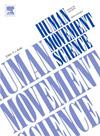Collision avoidance behaviours in chronic non-specific low back pain participants: A prospective cohort study
IF 1.9
3区 心理学
Q4 NEUROSCIENCES
引用次数: 0
Abstract
Objective
Chronic non-specific low back pain (cNSLBP) is a leading cause of disability, influenced by bio-psycho-social factors. However, its impact on everyday activities such as navigating streets and interacting with other pedestrians remains underexplored. This study aimed to assess the effect of cNSLBP on perceptual-motor processes in a pedestrian crossing task, focusing on 1) collision avoidance behaviours, 2) the walker's role in avoiding collisions, and 3) the influence of pain perception.
Methods
Seventeen asymptomatic adults (AA, 11 females, 46.4 ± 12.8 years) and seventeen cNSLBP participants (10 females, 47.9 ± 12.7 years) performed a task involving crossing paths at a 90° angle with another walker. Participants interacted in three groups pairings: AA-AA, AA-cNSLBP, and cNSLBP-cNSLBP. Key metrics included crossing order inversion, collision risk threshold informing movement adaptation, crossing distance, and the walker's contribution (speed/orientation).
Results and discussion
No significant differences were observed between groups for the collision risk threshold (≈0.93 m) or crossing distance (≈0.8 m). However, cNSLBP participants exhibited distinct avoidance strategies, especially in cNSLBP-cNSLBP interactions, which showed more frequent inversions. When crossing first, cNSLBP participants contributed less, whereas when crossing second, they contributed more, primarily by adjusting their speed. A significant negative correlation emerged between depression scores and the level of contribution when cNSLBP participants crossed second.
Conclusion
These findings suggest that pain perception may influence collision avoidance behaviours. Further research, potentially incorporating virtual reality, is needed to control environmental factors and deepen our understanding of these interactions.

慢性非特异性腰痛参与者的避碰行为:一项前瞻性队列研究
目的慢性非特异性腰痛(cNSLBP)是导致残疾的主要原因,受生物、心理和社会因素的影响。然而,它对日常活动的影响,如导航街道和与其他行人的互动,仍未得到充分研究。本研究旨在评估cNSLBP对行人过马路任务中感知-运动过程的影响,重点关注1)避碰行为,2)步行者在避碰中的作用,以及3)疼痛感知的影响。方法17名无症状成人(AA, 11名女性,46.4±12.8岁)和17名cNSLBP参与者(10名女性,47.9±12.7岁)与另一名步行者以90°角穿过路径的任务。参与者以三组配对进行互动:AA-AA、AA-cNSLBP和cNSLBP-cNSLBP。关键指标包括交叉顺序反转、碰撞风险阈值、交叉距离和步行者的贡献(速度/方向)。结果与讨论碰撞风险阈值(≈0.93 m)和穿越距离(≈0.8 m)两组间无显著差异,但cNSLBP参与者表现出不同的回避策略,特别是在cNSLBP-cNSLBP相互作用中,表现出更频繁的反转。当第一次穿越时,cNSLBP参与者的贡献较少,而当第二次穿越时,他们的贡献更多,主要是通过调整速度。当cNSLBP参与者过秒时,抑郁得分与贡献水平呈显著负相关。结论疼痛感知对避碰行为有影响。需要进一步的研究,包括潜在的虚拟现实,来控制环境因素并加深我们对这些相互作用的理解。
本文章由计算机程序翻译,如有差异,请以英文原文为准。
求助全文
约1分钟内获得全文
求助全文
来源期刊

Human Movement Science
医学-神经科学
CiteScore
3.80
自引率
4.80%
发文量
89
审稿时长
42 days
期刊介绍:
Human Movement Science provides a medium for publishing disciplinary and multidisciplinary studies on human movement. It brings together psychological, biomechanical and neurophysiological research on the control, organization and learning of human movement, including the perceptual support of movement. The overarching goal of the journal is to publish articles that help advance theoretical understanding of the control and organization of human movement, as well as changes therein as a function of development, learning and rehabilitation. The nature of the research reported may vary from fundamental theoretical or empirical studies to more applied studies in the fields of, for example, sport, dance and rehabilitation with the proviso that all studies have a distinct theoretical bearing. Also, reviews and meta-studies advancing the understanding of human movement are welcome.
These aims and scope imply that purely descriptive studies are not acceptable, while methodological articles are only acceptable if the methodology in question opens up new vistas in understanding the control and organization of human movement. The same holds for articles on exercise physiology, which in general are not supported, unless they speak to the control and organization of human movement. In general, it is required that the theoretical message of articles published in Human Movement Science is, to a certain extent, innovative and not dismissible as just "more of the same."
 求助内容:
求助内容: 应助结果提醒方式:
应助结果提醒方式:


